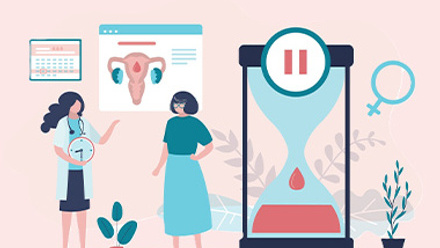Three top priorities for supporting employees through menopause

Since World Menopause Day was 18th October, it seems timely to focus on how employers should introduce menopause support. The purpose of the day is to raise awareness of the menopause and the support options available for improving health and wellbeing.
About 13 million British women are either peri- or postmenopausal, with some trans and non-binary people on similar journeys. So as an employer, how should you sensitively and inclusively provide support for this section of your workforce?
The impact of menopause in the workplace
Menopausal symptoms are varied, but the physical ones that have a particular impact at work include: regular hot flushes causing heavy perspiration and rapid heartbeat; urinary incontinence; joint soreness; insomnia; headaches and dizziness; and heavy or unpredictable periods. Women’s mental health at work can also take a severe hit as a result of depression and anxiety; fatigue; brain fog; and mood swings.
The related challenges at work go further than just the symptoms experienced by mind and body. There are additional complications driven by attitudes, culture and a lack of awareness.
In a 2019 survey by the Chartered Institute of Personnel and Development (CIPD), nearly a third of women experiencing menopausal and perimenopausal symptoms of all kinds had taken sick leave as a result and most also reported feeling unable to tell their manager the real reason.
Older women may be reluctant to admit going through something they fear will lead to them being perceived as unreliable or ‘past it’. In extreme cases, a difficult menopause may even push women to consider dropping out of hard-earned careers, just when they should be reaching their professional prime.
What can employers do to help?
A mixture of simple practical changes, policy amendments and cultural shifts can make a huge difference when it comes to being a menopause-friendly workplace. The CIPD has plenty of resources for HR teams looking to support female employees through the menopause.
Here is a brief overview of their top three priorities:
1. Review existing policies and frameworks
Look through your policies or frameworks covering health and wellbeing, flexible working and performance management and see if you are missing opportunities to raise awareness of the challenges menopause can cause and the simple actions that can help. In some cases, it might be worth developing a specific policy outlining your organisation’s commitment to supporting women through the menopause.
2. Help break the stigma
Despite the scale of the menopause challenge and its far-reaching consequences, it’s still often considered too personal – or possibly too shameful – to broach. Women may be reluctant or embarrassed to talk openly with managers or male colleagues (possibly because they may not even fully understand or correctly diagnose what’s happening to them). This sense of taboo continues the never-ending cycle of stigma in many organisations.
HR should:
- Promote awareness of the typical symptoms and the simple changes that can support women through the transition to all employees
- Provide information on how women experiencing the menopause can get the support they need.
- Balance personal stories with strong messages about the benefits of an inclusive organisation – wider efforts to foster an open and supportive culture will help to normalise the conversation.
3. Identify reasonable adjustments
Someone with menopausal symptoms should be supported in the same way as an employee with any ongoing health condition. Small adjustments to someone’s job or working pattern can help people manage their symptoms and continue to perform well in their role.
The individual is usually best placed to recognise what might help them, so encourage managers to have open conversations with members of their teams.
Fostering an age- and gender-inclusive workplace will help you tap into the valuable skills and talent that men and women of all ages have to offer.
The author is by Julie Stayte, Personal Group HRD.
This article is provided by Personal Group.
Supplied by REBA Associate Member, Personal Group
Personal Group provides the latest employee benefits and wellbeing products.







